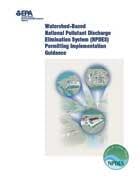Watershed-Based Permitting Continues Evolving
by Jay Collert, CHMM, CET
In Industrial WaterWorld’s September/October 2007 issue, I discussed how water quality trading began gaining traction at the EPA. The companion to that issue is the watershed-based permitting which is also moving forward. The genesis of watershed-based permitting was a policy memo issued by the EPA Office of Water Assistant Administrator on Dec. 3, 2002 – Committing EPA’s Water Program to Advancing the Watershed Approach. This memo not only reaffirmed its commitment to the approach, but also re-energized efforts to ensure the agency fully integrates it into its programs and supports regulatory authorities that implement water programs on a watershed basis.
In December 2003, EPA issued the Watershed-based National Pollutant Discharge Elimination System (NPDES) Permitting Implementation Guidance that describes its recommended steps and ideas for watershed-based permitting implementation under the NPDES permit program. This approach, aimed at achieving new efficiencies and environmental results through the NPDES program, provides a process for considering all stressors within a hydrologically defined drainage basin or other geographic area (e.g., municipality), rather than addressing individual pollutant sources on a discharge-by-discharge basis. The December 2003 guidance followed a long series of EPA guidance, policy and training supporting a watershed-based approach to addressing water quality concerns.
Updating the 2003 Guidance
In July 2007, EPA released Watershed-based National Pollutant Discharge Elimination System (NPDES) Permitting Technical Guidance. This document is a supplement to the 2003 Guidance, providing greater detail concerning a number of permit development and issuance questions not addressed previously. This document is focused on helping NPDES authorities develop and issue NPDES permits that fit into an overall watershed planning and management approach with input from watershed stakeholders. It consists of three chapters summarized below:
• Chapter 1 is Approaches to Water Quality Management Using an NPDES Watershed Framework. This Chapter discusses the NPDES program’s role in an overall watershed approach and presents a tool called the NPDES Watershed Navigator to develop a framework for structuring and managing implementation so the entire watershed is considered in the permit development process.
• Chapter 2 is Guide for Multisource Watershed-based NPDES Permitting. A potential outcome of the process described in Chapter 1 is a decision to develop a multisource watershed-based permit, which would allow point sources in a watershed to apply for and obtain permit coverage under the same permit for one or more pollutants.
• In Chapter 3, Watershed-based NPDES Permitting Case Studies, EPA has developed a series of case studies describing how watershed approaches have been implemented across the country.
Conclusion
It’s important to note many NPDES options discussed in this technical document, as well as implementation of other water resource programs that may be used to meet watershed goals, are addressed in other guidance or training provided by EPA and other agencies. Although most of the approaches and programs discussed are not new, this is the first time EPA has developed an integrated guidance regarding its relationship to the NPDES program within a watershed framework. Where appropriate, this document points readers to existing resources that provide additional technical assistance in implementing specific watershed-based approaches. For example, EPA’s Water Quality Trading Toolkit for Permit Writers complements this Guidance and helps facilitate incorporating water quality trading into NPDES permits.
About the Author: Jay Collert is director of the Aarcher Institute of Environmental Training LLC. Contact: www.aarcherinstitute.com

